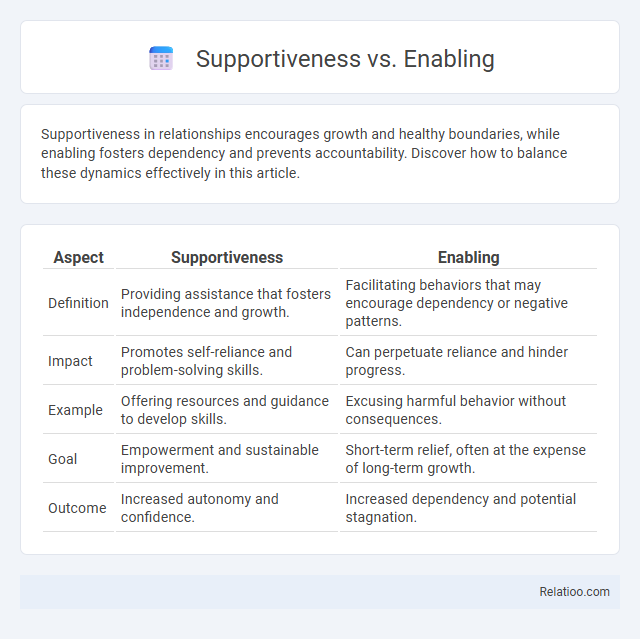Supportiveness in relationships encourages growth and healthy boundaries, while enabling fosters dependency and prevents accountability. Discover how to balance these dynamics effectively in this article.
Table of Comparison
| Aspect | Supportiveness | Enabling |
|---|---|---|
| Definition | Providing assistance that fosters independence and growth. | Facilitating behaviors that may encourage dependency or negative patterns. |
| Impact | Promotes self-reliance and problem-solving skills. | Can perpetuate reliance and hinder progress. |
| Example | Offering resources and guidance to develop skills. | Excusing harmful behavior without consequences. |
| Goal | Empowerment and sustainable improvement. | Short-term relief, often at the expense of long-term growth. |
| Outcome | Increased autonomy and confidence. | Increased dependency and potential stagnation. |
Understanding Supportiveness vs Enabling
Understanding supportiveness involves providing your loved ones with encouragement and resources that promote independence and growth, whereas enabling often unintentionally protects them from facing natural consequences, hindering personal responsibility. Supportiveness fosters resilience by empowering individuals to solve problems and make decisions, while enabling may perpetuate dependency and avoid addressing underlying issues. Setting clear boundaries helps maintain a healthy balance, ensuring your support strengthens rather than diminishes someone's ability to thrive on their own.
Key Differences Between Support and Enablement
Supportiveness involves offering encouragement and resources to empower others, fostering independence and growth. Enablement crosses into removing obstacles or taking over responsibilities, which can hinder personal accountability and development. Boundariedness maintains healthy limits to prevent over-involvement, ensuring support does not become enabling by clearly defining roles and expectations.
Signs You’re Being Supportive
Signs you're being supportive include actively listening without judgment, offering help that encourages independence, and respecting the other person's autonomy while showing empathy. Supportiveness involves providing emotional encouragement and practical aid that empowers rather than fosters dependency. Clear communication, consistent availability, and validating feelings are key indicators of a truly supportive relationship.
Signs You’re Enabling Negative Behaviors
Signs you're enabling negative behaviors include consistently rescuing someone from the consequences of their actions, making excuses for their harmful choices, and prioritizing their immediate comfort over long-term growth. Supportiveness involves encouraging accountability and healthy boundaries, whereas enabling blurs these lines and fosters dependency. Establishing clear, boundariedness ensures you support positive change while protecting your own well-being and promoting responsibility.
Psychological Impact of Support vs Enabling
Supportiveness fosters resilience and personal growth by providing encouragement and resources that empower Your mental well-being. Enabling, in contrast, can create dependency, hindering emotional development and potentially exacerbating unhealthy patterns. Establishing boundaries ensures healthy interactions, protecting Your psychological health while promoting autonomy and balanced relationships.
Healthy Boundaries in Supportive Relationships
Healthy boundaries in supportive relationships promote emotional resilience and mutual respect by clearly defining acceptable behaviors and limits. Supportiveness involves providing encouragement and assistance without fostering dependency, whereas enabling allows harmful behaviors to persist by removing consequences. Establishing boundariedness ensures that help is given compassionately while maintaining individual autonomy and self-care.
Common Situations: Support or Enablement?
Supportiveness involves providing encouragement and resources to help someone grow, while enabling often means unintentionally maintaining harmful behaviors by removing consequences. Boundariedness protects your well-being by setting clear limits, which is crucial in situations where offering help could inadvertently support dependency. Understanding these distinctions in common situations allows you to offer genuine support without fostering enablement, preserving healthy relationships.
How to Shift from Enabling to Supporting
Shifting from enabling to supporting requires recognizing behaviors that unintentionally perpetuate dependency and replacing them with actions that promote autonomy and accountability. Establish clear, healthy boundaries that empower individuals to develop problem-solving skills while providing emotional encouragement. Emphasizing support over enabling fosters resilience and self-efficacy, ensuring help is constructive rather than fostering reliance.
Communication Strategies for Healthy Support
Effective communication strategies for healthy support involve clearly expressing needs and limits to foster supportiveness without enabling harmful behaviors. Active listening promotes understanding and validation, while setting firm boundaries maintains mutual respect and personal well-being. Using "I" statements and reinforcing consequences helps prevent dependency, encouraging autonomy and sustained emotional health.
Supporting Personal Growth Without Enabling
Supportiveness fosters Your personal growth by offering encouragement and resources that build independence, while enabling unintentionally promotes dependence by shielding from consequences. Establishing clear boundaries ensures that support empowers rather than hinders development, allowing individuals to face challenges and learn from mistakes. Balancing empathy with limits creates a healthy environment where growth thrives without fostering reliance.

Infographic: Supportiveness vs Enabling
 relatioo.com
relatioo.com